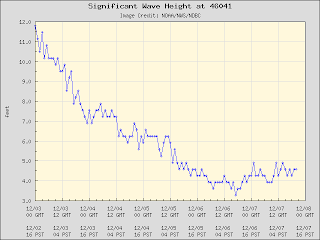During roughly the past week, sea level pressure has been unusually high--including the record-breaking high pressure observed on December 1 (1043.4 hPa). Here is the pressure of the last four weeks. The first three weeks had relatively normal sea level pressures (1000-1020 mb), but the last week or so, pressures have generally ranged from roughly 1030-1035 mb. Very unusual to stay that high for so long.
We have also been observing another anomaly: the height of the water levels in the region have been unusually LOW, particularly along the Pacific coast. NOAA produces water-level predictions = (the tide tables we know so well) and these predictions are generally quite good, since we understand very well what produces tides and their periodicities. But recently the tide predictions have been greatly in error, forecasting tides that are much too high by one or two feet! Here is the predicted and observed water level at Neah Bay, provided to me by UW's Dr. Nate Mantua.
Turns out these two anomalies (high pressure and low water levels) are directly connected, with high pressure pushing water levels down.
The general term for this mechanism is the inverse barometer, and is often used to explain unusually high water levels when low pressure is over a water-covered area (see graphic)--and you may
remember that I wrote about this a few years ago when record low pressure spread over the west coast (click here for my past blog). In general, the water level should sink around 1 cm for every mb pressure increases. We have experienced about a 20 mb high-pressure anomaly, and thus one would expect water levels around 20 cm (8 inches) below normal.
However, there is something else going on here. The center of the high pressure has generally been offshore and as a result northerly winds have been persistent along the Northwest coast (see graphic from WRF model forecast):
Northerly winds put a force on the water to the south, but because of the Coriolis effect, there is an offshore component to the surface currents. Thus, surface currents are pulling water AWAY from the coast, further reducing the height of the water surface.
And it is better than that if you like low water levels. With a complete absence of storms there are no strong winds pushing water up on the coast and very weak wave action. Take a look at the wave heights along the Washington and Oregon coasts at two NWS coastal buoys for the past five days (46041 off of WA, 46050 off of Oregon). Waves progressively decreased to 4-5 ft. Good time for fishing?
We will be stuck in this pattern (high pressure, low clouds west of the Cascade crest, air pollution) for several more days, so you better get used to it. Want sun, head into the mountains or eastern WA or OR.
PS: If you want me to answer a question on-air on KPLU on Friday at 9 AM, you can leave it at this link.
This blog provides forecasts weather or other topics
Subscribe
Popular post
-
I didn't want to mention this, worrying I might jinx it, but it is clear that August 2012 will the driest in Seattle history. So far we...
-
Your plants know it, and so will your water bills if you have a garden. Over western Washington most places have not seen rain in roughly f...
-
Today was very warm around western Washington, with some stations (like Sea Tac ) breaking their all-time daily record. Now let me make one...
-
Wed Morning Update: The pressure differences across the mountains have weakened and the winds of Ellensburg have died down. Temperatures t...
-
It is not unusual during summer to view a satellite image like the following, with a narrow sliver of low cloud along the Northwest coast. ...
-
Well, one thing a forecaster learns quckly is humility. There is a weak upper level disturbances that is causing this light precipitation. ...
-
The front made it in late this afternoon and early evening as shown by the infrared satellite photo above. Winds really increased this afte...
-
A weak cold front is now moving into western Washington (see satellite and radar) imagery...with increasing clouds and a few light showers o...
-
Click on picture for Dale Ireland's time lapse movie of today's action. Its cold, windy, with heavy rain in places. Convective show...
-
A week ago I received an unusual call from Eric Swansen, Managing Director of the Regional Animal Services of King County. He had looked at ...
Blog Archive
-
▼
2011
(211)
-
▼
December
(15)
- Finding Sun
- Subtropical Moisture, Record Lost, and Thank You
- The Christmas Day Storm
- The Big Shift in Our Weather
- Where is La Nina?
- The Surface Data Revolution
- How is the snowpack doing?
- Drought
- Surface, Air, and Soil Temperatures: The Differen...
- Fog Outside, Desert Humidity Inside
- Amazing Fog Pictures and Inversions
- High Pressure Produces Low Sea Level
- Seattle's Math Secret Revealed (Revised)
- The Irony of Wintertime High Pressure
- History is Made: Highest Pressure in Sea-Tac Hist...
-
▼
December
(15)
Powered by Blogger.
Support :
Creating Website | Johny Template | Mas Template
Copyright © 2011. The Weather - All Rights Reserved
Copyright © 2011. The Weather - All Rights Reserved















